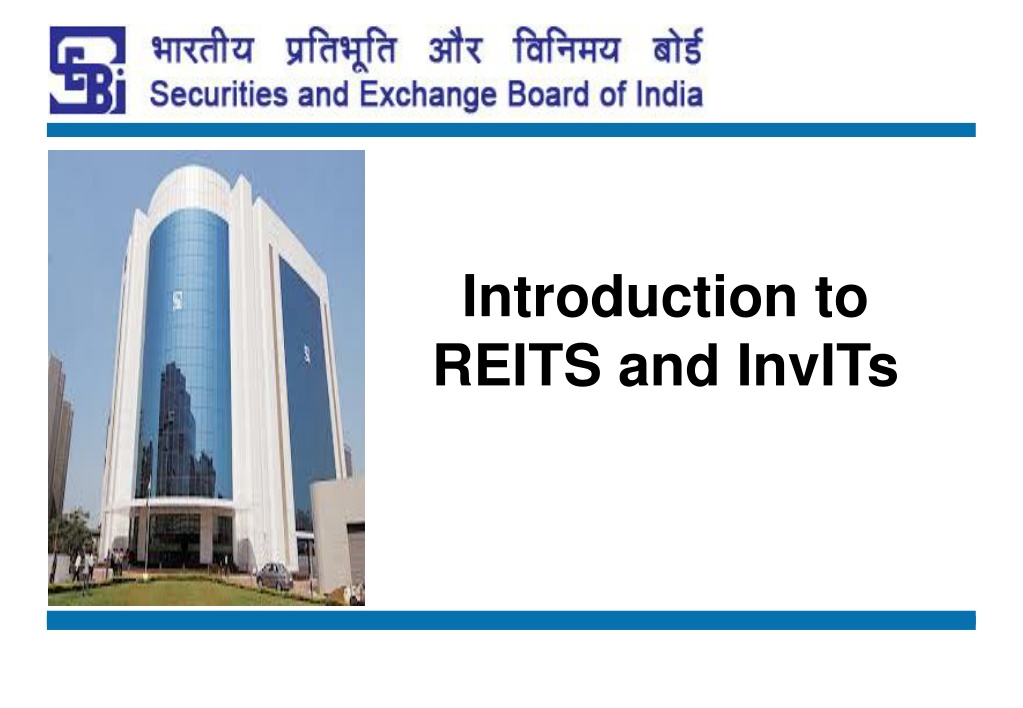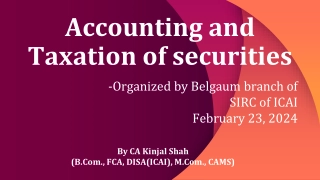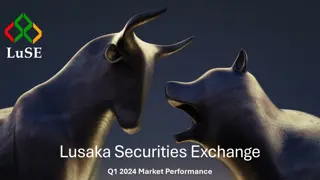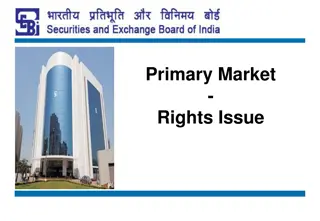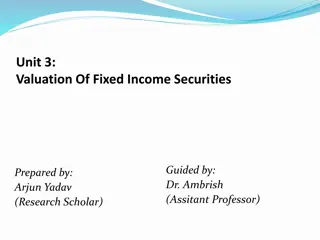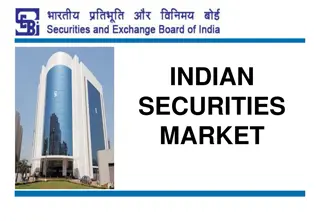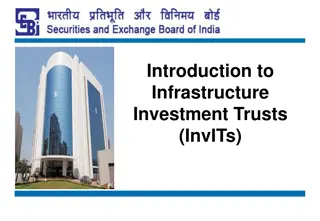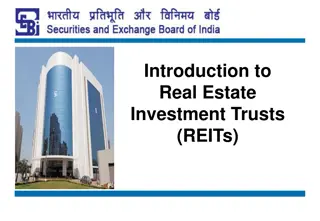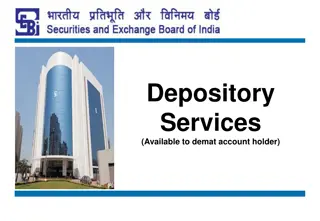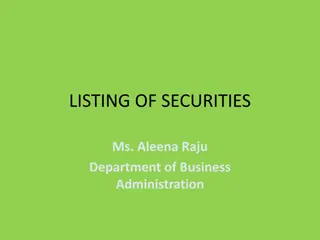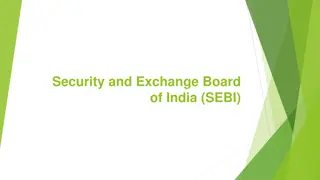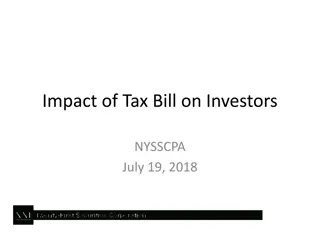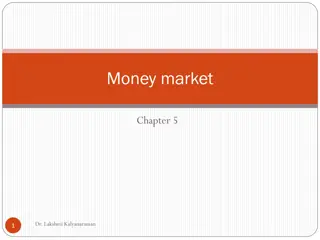Understanding REITs and InvITs in the Securities Market
REITs, or Real Estate Investment Trusts, offer investors the opportunity to own and invest in income-generating real estate assets. They are listed on stock exchanges and must distribute a significant portion of their cash flows to investors. REITs are structured with sponsor and investor ownership, management services, and hold assets in trust. They provide a hybrid investment opportunity between equity and fixed income, offering both cash yield and potential capital appreciation. Details of listed REITs like Embassy Office Parks and Mindspace Business Parks showcase their market capitalization, sectors, and geographic focus.
Download Presentation

Please find below an Image/Link to download the presentation.
The content on the website is provided AS IS for your information and personal use only. It may not be sold, licensed, or shared on other websites without obtaining consent from the author. Download presentation by click this link. If you encounter any issues during the download, it is possible that the publisher has removed the file from their server.
E N D
Presentation Transcript
Introduction to REITS and InvITs
DISCLAIMER The information contained in this material is for only educational and awareness purposes related to securities market and shall be used for non-profitable educational and awareness activities for general public. No part of this material can be reproduced or copied in any form or by any means or reproduced on any disc, tape, perforate media or other information storage device, etc. without acknowledging the SEBI or Stock Exchanges or Depositories. SEBI or Stock Exchanges or Depositories shall not be responsible for any damage or loss to any one of any manner, from use of this material. Every effort has been made to avoid errors or omissions in this material. For recent market developments and initiatives, readers are requested to refer to recent laws, guidelines, directives framed thereunder and other relevant documents, as being declared from time to time. For any suggestions or feedback, you may send the same to visitsebi@sebi.gov.in. 2
What is a REIT ?- Overview REIT stands for Real Estate Investment Trust . REITs own, operate and manage a portfolio of income generating real estate assets. REITs give investors access to the benefits of owning high-quality real estate assets in small ticket sizes. REITs are listed on the stock exchanges and investors can buy REIT units just like they would buy shares of any listed company. REITs are regulated investment structures that MUST pay out 90% of the Net Distributable Cash Flows (NDCFs). Indian REITs have adopted stringent corporate governance standards, with transparent quarterly and semi-annual reporting, robust related party safeguards, caps on leverage, and professional management teams. 4
Structure of REIT Sponsor / Investor Ownership of units Distribution of cash flows Holds the REIT assets in trust for the benefit of the Unit holders Management Services Manager Trustee REIT Manager Fee Distribution of Cash Flows Holding Company Distribution of Cash Flows SPV SPV 5
REITs A Hybrid Product between Equity and Fixed Income Fixed Income REITs Equity Regular and growing cash yield Appreciation through increasing property valuation Yield Oriented Capital Appreciation Oriented 6
Details of Listed REITs Embassy Office Parks Mindspace Business Parks EMBASSY MINDSPACE Ticker (NSE) 542602 543217 Ticker (BSE) April 01, 2019 August 07, 2020 Listing Date Market Capitalization1 28,386 crores 17,802 crores Office Office Sector Focus Bengaluru, Mumbai, Pune, Noida Mumbai, Hyderabad, Pune, Chennai Geographic Focus 33.3 msf 29.5 msf Total Leasable Area2 24.2 msf 21.2 msf Leased Area2 Blackstone, Embassy Group K Raheja Corp Sponsors 7
Who can Invest in REITs? Any investor (domestic / foreign / retail / institutional) can buy REIT units in India Minimum lot size of 200 units (and multiples thereof) Unit-holders can purchase REIT units through a Demat account, similar to how they would purchase equity shares REIT units can be bought / sold freely on Stock Exchange platform Investors can also buy REIT units through participation in REIT IPO whenever a REIT gets listed 8
Benefits of Investing in REITs? Liquidity Transparency Asset Quality REIT units are freely traded in stock markets like equity shares Strong governance framework and disclosure requirements from SEBI Fractional ownership in professionally-managed Grade A commercial assets Distributions Performance Diversification Income stability due to requirement to distribute at least 90% of cash flows semi-annually Upside participation in capital appreciation from organic / inorganic growth Investment in a high-quality diversified portfolio across sectors / cities 9
Comparative Analysis Vis- -vis traditional investments Direct Investment in Real Estate REIT Units Real Estate Equity Shares Minimum lot size of 200 units 25-200 crores investment Minimum lot size of 1 share Freely transferable listed securities Illiquid & non-transparent market Freely transferable listed securities Investment Characteristics Professionally managed Hassles in managing assets Professionally managed No entry / exit load Usually grade A assets in prime locations, primarily office Transaction costs involved No entry / exit load Usually grade A / B assets with a mix of office / residential / retail Multiple tenants across sectors Usually strata interests in standalone buildings Asset and Tenant Quality Usually exposed to single tenant risk Multiple marquee tenants across sectors Returns driven by capital appreciation and regular cash distribution (90% mandatory) Returns driven by capital appreciation and dividends (NOT mandatory) Returns driven by a timely and profitable exit Return Profile Dividends are tax exempt Dividends are taxable Dividends are taxable Tax Efficiency Restricted to 49% Net debt / Total Enterprise Value Leverage Profile No restrictions No restrictions Governance Standard High High Lower than REIT standards Lower than other commercial real estate vehicles High Higher than REIT profile Risk Profile 10
What Assets Can a REIT Own? NOT Commercial Sectors PERMITTED Rental income Residential (houses, apartments) earning real estate projects Offices, hotels, retail, industrial, healthcare Speculative landbank Leverage Restrictions Min. 80% Max. 20% Unitholder approval needed for Debt to Capitalization above 25% completed & income producing assets under-construction assets Debt to Capitalization capped at 49% 11
How do REITs Generate and Distribute Income? Rental income is generated from underlying real estate assets held in the portfolio High-quality institutional grade commercial properties in key metro cities attract premium rentals Asset Quality Diversified and high-credit quality tenants generally pay rentals on time Tenant Quality Stable cash flows due to long-term nature of lease contracts Lease Term Minimum 90% of the available NDCF is REQUIRED to be distributed to unitholders (at least semi-annually) 12
Disclosures to Unit-holders by the REIT Investors are advised to regularly refer to the disclosures / communications sent by the REIT and stay aware about their investments Half-yearly Report Earnings Materials Earnings Call Held quarterly by management Published semi-annually Published quarterly and benchmarked to global disclosure standards (NOT Required by Listed Companies) Unitholder Meetings & Webinars Independent REIT Valuation Annual Meeting Held once a year Conducted half-yearly Held throughout the Year 13
What are InvITs Purpose : encouraging and providing additional financing for investment in the infrastructure sector in India Supports diversification of ownership of infrastructure assets such as power transmission, roads, ports, renewable projects The trust is created by the Sponsor, the ownership of the property vests in the Trustee and the beneficiaries of the trust are the Unitholders. InvITs aim to provide stable long term cash flows to its unitholders; suited for long term capital such as Pension Funds and Insurance Companies 15
Benefits of investing in InvITs InvIT 1 2 3 4 5 6 Free Up Developer Capital for Reinvestment into New Infrastructure Projects To Bring Higher Standards of Governance into Infrastructure Development and Management Provide Long-term Financing Option for Existing Infrastructure Projects Low-risk investments offered to attract long- term investors such as insurance and pension funds Facilitation of ownership of diversified Infrastructure Assets for retail investors Growth Potential for Investors InvITs facilitate creation of infrastructure assets by providing better financing and ownership opportunity while generating healthy returns for investors 16
Structure of InvITs Sponsors Investors Sets up InvIT No lock-in units freely tradeable from listing date Lock-inrestrictions TrusteeshipFee Asset ManagementFee Trustee InvestmentManager InvIT Holds InvIT s assets for the benefit of unit holders Manages and makes investment decisions in underlying assets InvIT relation to 100% equity O&MContracts Project Manager SPV 1 SPV2 SPV3 Undertake management of InvIT assets operations and Assets Assets Assets 17
Key parties in InvITs Author of the trust Required to hold at least 15% of the total InvIT units for a period of 3 years from the date of listing of such units Sponsor Independent debenture trustee registered with SEBI and responsible for holding the InvIT assets in trust for, and for the benefit of, the unit holders of the InvIT Oversees some of the activities of the project manager (and the investment manager Trustee Investment Manager Responsible for the day-to-day management of the InvIT and its activities Makes investment decisions Ensures redressal of investor grievances Project Manager Responsible for the execution and management of the project assets held by the InvIT Undertakes operation and management of the InvIT Oversees projects operations / maintenance / construction 18
Types of InvITs Based on the mode of issuance, there can be three types of InvITs: Privately placed listed InvITs Publicly offered listed InvITs - Only to institutional investors (min 5, max 1000 investors) - Minimum investment (Rs. 1 crore/ 25 crore) and trading lot (Rs. 1 crore/ 2 crore) - Units offered to public (min 20 investors) - Minimum investment and trading lot Rs. 1 lakh Privately placed unlisted InvITs - Only to institutional investors (max 1000 investors) - Minimum investment (Rs. 1 crore) 19
Details of InvITs - List of Indian InvITs and the sectors in which they have invested is give below: Public InvITs Private listed InvITs Private unlisted InvITs IRB InvIT Fund (Highways) India Grid Trust (Power Transmission) Indinfravit Trust (Highways) Oriental InfraTrust (Highways) India Infrastructure Trust (Gas Transmission) Tower Infrastructure Trust (Telecom Towers) IRB Infrastructure Trust (Highways) Digital Fibre Infrastructure Trust (Telecom Fibre Optic) 20
Cash flow in InvITs : An illustration Unitholders Distributed to Unitholders For tax treatment in the hands ofUnitholders, Unitholders investment InvIT by subscribing to its units make into distributions are divided into Dividend Interest Return of Capital InvIT InvIT Distributions in the formof: InvIT SPVs in the form of Equity invests into Dividend Interest Return of Capital SPV 1 SPV 2 SPV 3 21
Where can an InvIT invest its funds ? At least 80% of the value of a public InvIT to be invested in completed and revenue-generating infrastructure projects. A maximum of 20% of the total value of InvITs can be from: Under construction infrastructure projects Listed or unlisted debt of the companies in the infrastructure sector (other than debt of Hold Co/SPV) Equity of listed companies in India generating at least 80% of their income from the infrastructure sector Government securities, money market instruments, liquid mutual funds or cash equivalents Privately placed InvIT can have any mix of under construction and completed infrastructure projects. 22
Rights of unit holders in InvITs Right to receive returns through cash distributions made by the trust Rights to vote on matters pertaining to acquisition of new assets or borrowing Right to vote on related party matters Right to vote on matters such as appointment or change of the Investment Manager Right to vote on induction of a Sponsor, with the opportunity to exit for dissenting voters Right to vote on exit of Sponsor Right to receive periodic disclosures like annual report, valuation report, quarterly/ semi-annual financials etc 23
Thank You 24
